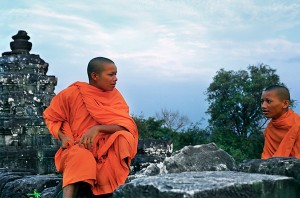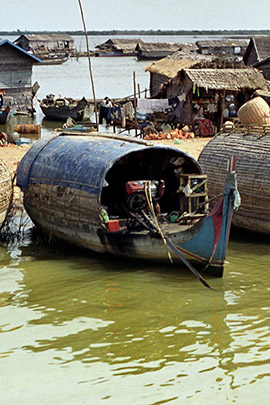When human beings cooperate and form a civilization it seems they can’t help but leave behind traces of their existence—a legacy that can take many forms. A new language, new art, new infrastructure. But once that empire falls, their remnants can also stand as a reminder of the frailty of our own present-day empires. The remnants of power that exist in Cambodia are of the Khmer (Angkor) Empire: a once powerful empire that dominated Southeast Asia from the ninth century AD until about 1397 AD. The Khmer Empire flourished under its many kings who were able to establish power quickly and usually without conflict due to strong trading relationships with its neighbours. The wealth and power flowed easily, thanks to the abundant resource and strategic advantage the Mekong River afforded the empire.

The Mekong not only enabled Angkor to export their goods for trade to its neighbours with ease, but also proved to be an excellent fishing resource. Because invaders had to travel up the river to raid it also made Angkor very difficult to attack. Taking full advantage of the Mekong, the former Angkor monarchs established themselves as rich and powerful rulers, able to undertake ambitious construction projects. Most famously is the impressive Angkor Wat, a temple built early in the 12th century for King Suryavarman II. It was a temple for worship but also served as a political capital. The architecture is impressive even by today’s standards. Studying the massive temple not only commands appreciation for the ingenuity that went into its construction but also demands an explanation for how the power that built it could ever fall. Many factors are to blame. Academics guess that two of the main reasons have to do with the popularization of a new belief system and the loss of legitimacy of the ruling monarch, or “god-king”.

In the 13th century, Hinduism and Mahayana Buddhism were the prevailing belief systems in Angkor culture. These belief systems were in harmony with the idea that kings were an authority to be obeyed. Enter Theravada Buddhism. This belief system promoted an abandonment of worldly things, self-actualization through looking inward and a disregard for superstitious beliefs. Indirectly this challenged the monarch’s authority given that Angkor’s king was regarded as a god-king. With citizens of Angkor not recognizing the authority of their god-king, who demanded an army and a subservient workforce, the empire’s foundations seemed to shake, leaving them vulnerable to the attacks of invaders, virtually crippling the entire empire.
The visuals of Angkor Wat, grown over by strangler fig and silk-cotton trees, should remind us of the frailty of our own present-day empires.











